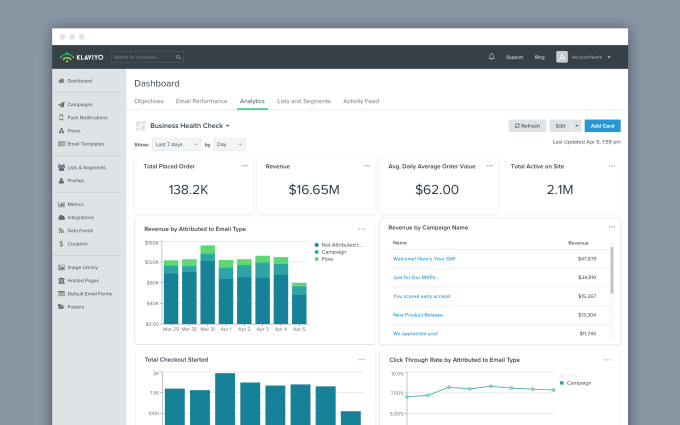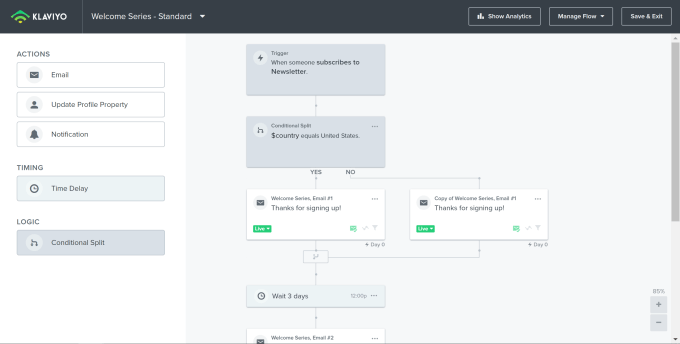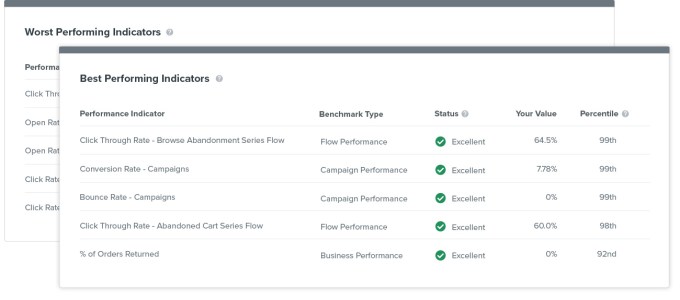Email is the communication medium that refuses to die.
“Eventually, every technology is trumped by something new and better. And I feel that email is ready to be trumped. But by what?” wrote the venture capitalist Fred Wilson in 2007. Three years later, he updated readers that other forms of messaging had outgrown email. “It looks like email’s reign as the king of communication is ending and social networking is now supreme,” he said. (To be fair to Wilson, his view was nuanced enough to continue investing in email tech.)
Despite the competition, Klaviyo didn’t just break into the market — it has also achieved an unusual level of excitement and loyalty among marketers despite its youthful history.
Investors weren’t alone — marketers have also spent years anticipating the next big thing.
“It was SMS, it was YouTube, it was Instagram. Before that it was Facebook, then it was Snapchat and TikTok. I kinda feel like individually all those things are fleeting. I think people found: You know what? Everyone still opens their emails every day,” says Darin Hager, a former sneaker entrepreneur who is now an email marketing manager at Adjust Media.
Email has an estimated four billion users today and continues to grow steadily even as mature social networks plateau. Estimates of the number of nonspam messages sent each day range from 25 billion to over 300 billion.
Unsurprisingly for a marketing channel with so much volume, there’s voluminous competition to send and program those emails. Yet, despite the competition, Klaviyo didn’t just break into the market — it has also achieved an unusual level of excitement and loyalty among marketers despite its youthful history.
“If you’re not using Klaviyo and you’re in e-commerce, then it’s not very professional. If you see ‘Sent by Constant Contact or Mailchimp’ at the bottom of an email by a brand, it makes it look like they’re not really there yet,” Hager said.
How did Klaviyo become the standard solution among email marketers?
In Klaviyo’s origin story, we delved into part of the answer: The company began life as an e-commerce analytics service. Once it matured to compete as an email service provider, Klaviyo benefited from the edge given by its deeper, more comprehensive focus on data.
However, that leaves several questions unanswered. Why is email so important to e-commerce? What are the substantive differences between Klaviyo’s feature set and those of its competitors? And why did several large, well-funded incumbents fail to capitalize on building an advantage in data first?
In this section, we’ll answer those questions — as well as laying out the significance of COVID-19 on the e-commerce market, and how newsletters and AI figure into the company’s future.
A positive Outlook on email’s longevity
Email is one of the oldest tech verticals: Constant Contact, one of the most venerable email service providers (ESPs), was founded in 1995, went public in 2007 and was taken private in 2015 for $1 billion. By the time Klaviyo started in 2012, the space was well served by numerous incumbents.
With so many alternatives for communications as well as social media arising over the past two decades, why has email been so resilient? The technology has two major advantages that have helped it maintain its status as the premier communication channel for many purposes, including e-commerce messaging.
First, email is a purely asynchronous medium. Users choose the intervals at which they check emails and can quickly scan through and sort their inbox. As a result, email is uniquely well suited to high volumes of messages ranging in importance from vital to completely worthless in the case of spam.
Second, and perhaps more importantly, nobody owns email. Social networks and messaging apps often start out open and free for all users — but over time, their owners act to control, limit or charge money for marketing communications. Sending a message through email has remained cheap, and despite a years-long crackdown against spam, Google and other major email inbox providers have not prevented the deliverability of legitimate marketing communication.
This openness and freedom has driven the trend around “owned marketing” in e-commerce: The realization that no platform or partner can replace an independent storefront and an email list under one’s control. While many marketers have made money off Amazon or Facebook, competition on such platforms inevitably rises, and often, the only way to stand out is to pay for better ad space. A brand with its own independent store, along with a list of customer email addresses, has an off-ramp from these escalating costs.
In retrospect, Klaviyo’s co-founders appear to have been prescient about email’s importance. Klaviyo co-founder Ed Hallen even noted that when Klaviyo started, email was not regarded as an exciting domain, and the fledgling startup failed to secure a spot in Boston-area startup accelerators when it applied.
Where Klaviyo fits among the competition
If Klaviyo was prescient, though, the same could be said of a bevy of competitors.
Dozens of companies compete within the email service provider space, as befits a 50-year-old technology. At first glance, the abundance of options can make it difficult to understand why any individual company stands out.
“When I first got introduced to Klaviyo, my reaction was, why is this so interesting? It’s email marketing, which everyone else has been doing for 20 years,” says Kady Srinivasan, a former head of global growth marketing at Dropbox who is now Klaviyo’s senior vice president of marketing.

Klaviyo’s senior vice president of marketing Kady Srinivasan. Image Credits: Klaviyo
To answer this, we have to look at the evolution of ESPs and how successive generations have offered more capabilities to users.
First-generation ESPs were companies that, more or less, invented the concept of email marketing. Just as the world wide web was getting underway, Constant Contact found a dedicated audience among doctors, plumbers and hairdressers migrating away from the paper-based Yellow Pages and onto the internet. During the height of this generation, emails were typically plain text and the killer feature was simply being able to send them reliably and in volume.

Humans once learned where to shop from yellow papers bound together into book format. Image Credits: Justin Sullivan/Getty Images
As the new century rolled in, marketers realized that, much like websites, emails could be well designed and beautiful. Plain text was out and rich text was in. This second generation of ESPs is perhaps best personified by Mailchimp, which started as a side project in 2001 and became a full-fledged company in 2007. Mailchimp and similar services effectively modernized the look and feel of email marketing while also solving back-end problems like deliverability — a key challenge for marketers as inbox providers like Gmail (which launched in 2004) increasingly filtered email for spam algorithmically.

Mailchimp co-founder and CEO Ben Chestnut at TechCrunch Disrupt San Francisco 2019. Image Credits: Kimberly White/Getty Images for TechCrunch
Some marketers feel that the second generation of ESPs is also where the market took a wrong turn, however. Most new ESP startups were centered around designing beautiful emails — functionality that was, ultimately, easy to copy.
“New entrants could easily get started and they’d compete mostly on price,” says Steve Deckert, a former e-commerce entrepreneur who is now director of business development for storefront platform WooCommerce. “It was somewhat of a race to the bottom.”
Klaviyo represents the vanguard of a third generation of ESPs: One focused on analytics and performance marketing, often using terminology like “automated customer experience management.” It’s a crop of companies that includes ActiveCampaign and Listrak and Oracle NetSuite’s Bronto. Bronto, one of the best-known companies in this group, just shut down a few weeks ago in a potential win for Klaviyo.
Most notable is the fact that Klaviyo doesn’t even bill itself as an email company, and every employee interviewed for this article was keen to talk more about the company’s data collection and processing.
“At our heart, we are an analytics engine. It’s a little different from how a lot of vendors in our space have approached this. A lot of vendors approach it as solving a marketing problem, building marketing tools,” summarizes Conor O’Mahony, Klaviyo advisor and recently departed chief product officer.
The answer is always in the data
Even if one splits ESPs into generations, it can still be difficult to parse exactly why Klaviyo, among an overabundance of email companies who all tout their analytics and automation, has become the current darling of e-commerce. Even more surprising is that Klaviyo’s two most-used features, Campaigns and Flows, can also be found in competing services. To an inexperienced eye, these two features look similar across most ESPs.

Klaviyo’s dashboard interface for email marketers. Image Credits: Klaviyo
To an extent, that similarity is because the practice of email marketing is well established. Campaigns are the classic marketing email, sent to customers when a brand has something to announce. A single email notifying you of a new seasonal sale is a campaign. Some campaigns get more complex, such as a series of emails that starts by introducing you to a new outdoor grill, follows up with recipes, and, finally, offers a deal (marketers would refer to this as a drip campaign).
A flow, by comparison, is a more recent development in email. Simply put, a flow is an automated email sent because of an action a customer took. For example, a potential customer who leaves a site without completing their purchase may later get an automatic flow email encouraging them to return. Flows can involve multiple, conditional steps — if the same customer returns to the site without purchasing again, the next email they receive might offer a discount.

Klaviyo’s Flows are a sort of no-code visual programming environment for setting up potentially complicated email triggers. Image Credits: Chris Morrison
So what makes Klaviyo’s Campaigns and Flows different? The company itself would argue that it does, in fact, beat the competition on email design and aesthetics — another of its main features is a large library of email templates. But the core feature that sets Klaviyo apart is largely invisible, residing in the breadth and depth of the data it collects and stores natively. Despite having had several years to catch up, most ESPs still act as a layer on top of external data stores.
“I think because Klaviyo focuses on customer data first, they’re able to provide us with a lot of information and elements you just don’t find in other ESPs,” says Will Critcher, the director of e-commerce for Death Wish Coffee.
Critcher says a large part of Death Wish’s decision to use Klaviyo was based on the company’s integrations, which allow data to be imported or exported from any one of several hundred other software suites. For example, Klaviyo email lists can be used to build Facebook Lookalike Audiences, which are a typical tool used by marketers to advertise to new customers.
While integrations are, again, a feature also offered by competitors, Klaviyo has been able to build a larger library of them because the company takes on the role of a central data warehouse, obsessively collecting every scrap of data it comes across. When Death Wish was recently looking for a piece of customer data, the company found that only Klaviyo stored it — even Shopify, its storefront platform, wasn’t tracking it. “It wouldn’t be wrong of most people to think: Isn’t this just something you could get from Shopify? Surprisingly, no,” says Critcher.
By collecting more data and normalizing it better, Klaviyo has the foundation to enable its customers to effortlessly build more targeted marketing segments. Its Flow Builder is designed around this data and utilizes an interface in which users snap together conditional blocks based on user segments. Klaviyo goes so far as to call Flows a visual programming interface — something of a no-code offering for marketers who would otherwise have to code data retrieval operations themselves. Flows are also built for speed — being able to snap together segments quickly lets customers try out more targeted messages and see how they perform.
“For us, internally when we’re building products, but also for our users, we want them to run as many experiments as possible,” says Andrew Bialecki, Klaviyo’s CEO and co-founder.
While the typical customer comes to Klaviyo for its email offerings, some have also begun to use the platform as a customer relationship management (CRM) tool and data warehouse. Users can retrieve data outside of its messaging features for purposes like bookkeeping, reviewing order histories, or analysis, essentially making Klaviyo one of the key systems of record for stores.
Finally, Klaviyo is in the process of rolling out a new set of data features, such as using anonymized data from across its customer base. The first such feature, called Benchmarks, compares a user’s performance to a hundred of its closest peers on metrics like email open rate and revenue per message, giving marketers insights on how their campaigns and flows stack up competitively.

Benchmarks will allow Klaviyo’s users to compare their performance to an anonymized cohort of similar peers. Image Credits: Chris Morrison
COVID-19 and a rapidly changing e-commerce landscape
It’s rather obvious, if painful to say outright, that COVID-19 afforded an enormous windfall for the entire e-commerce industry.
Klaviyo caught a lot of attention in November 2020 when it raised a $200 million Series C venture capital round led by Accel, valuing the company at $4.15 billion. That sizable investment followed close on the heels of a $150 million Series B in April 2019, which was led by Summit Partners.
Competitors haven’t been lying still. Just in the past year or so, ActiveCampaign raised $100 million, while Bluecore secured $50 million. But Klaviyo’s $350 million, two-year haul suggests that it may have grabbed an outsized portion of the pandemic’s e-commerce spurt.
Klaviyo’s performance during 2020’s Cyber Weekend (which includes Black Friday through Cyber Monday) gives us another indication of the pandemic’s effect: Its customers sent out 4.4 billion emails across those four days — twice as many as the year before — and generated over $1 billion in revenue attributable to Klaviyo, according to the company.

Holiday e-commerce sales have skyrocketed. Image Credits: Justin Sullivan/Getty Images
But Bialecki says that more than raw growth or revenue, the most interesting aspect of the pandemic has been watching brick-and-mortar businesses decide that online isn’t so bad, after all.
“If you walk into an actual store, you’re really anonymous. The business doesn’t really know who you are. What’s interesting about the shift to people moving online is that, all of a sudden, you are known,” says Bialecki. “Once you know who they are, you can start to build a personalized experience for them. Both in the moment, but also longitudinally.”
Others in e-commerce agree that a sea change is taking place in the wake of the pandemic.
“This isn’t simply us fast-forwarding five years and speeding up the adoption of online. This is businesses choosing to sell online that otherwise wouldn’t have,” says WooCommerce’s Deckert. “There’s a brewery down the street from me that makes really good craft beer. I don’t know if they would ever have sold online if not for the pandemic, and there’s a plethora of businesses like that.”
Guided software and the future of Klaviyo
With e-commerce growing at breakneck speed, Klaviyo could easily continue in its current direction of collecting more data and improving the tools for marketers to use it. Instead, the company has two new directions in mind for its business.
Benchmarks, the feature that compares its customers to a cohort of similar peers, gives a hint at what Klaviyo will be doing in the future. The company had observed that its customers had to poll their peers or lurk in online forums to try to pick up bits and pieces of information about performance and were often uncertain even after their research.
“Before we launched that feature, people were flying blind. They could say, ‘Hey, I’m doing 5 cents,’ and maybe they have a friend who’s doing 10 cents, but there was no easy or scientific way to know where they stood,” says Eric Silberstein, Klaviyo’s vice president of data science.

Klaviyo VP of Data Science Eric Silberstein. Image Credits: Klaviyo
Adding benchmarking is complementary to Klaviyo’s drive to capture customers smaller than its current audience, which is heavy on SMBs and midmarket businesses. Even smaller customers, which Klaviyo refers to as entrepreneurs, don’t have the time or resources of a dedicated professional.
“We provide a lot of raw tools today for customers to put their data to work, build segments, view reports and automate, but they’re not making the most of Klaviyo, they feel,” says Alexandra Edelstein, a Klaviyo group product manager. “Our data science team isn’t focused on buzzwordy AI features, they’re focused on how we can save them time, how can we recommend what we can do next to make engagement increase.”
Eventually, Klaviyo wants to use features like benchmarks to become a guided software platform, or what our very own Danny Crichton called “best practices as a service” on Extra Crunch recently. Silberstein says, “I have a feeling five years from now, people will look back and say, ‘Oh, that’s so primitive,’ just like how we’re now amazed someone used to spend three weeks installing software. I believe it’s going to be a leap like that; it’ll be table stakes if the software doesn’t guide you.”
Besides guided software, Klaviyo is eyeing markets beyond e-commerce for expansion.
“What Klaviyo was early on was an incredibly powerful data engine taking from different systems. The first outcomes were mostly e-commerce focused … [and] email was the means of driving that customer interaction, but that’s just because that’s the way their customers wanted to receive messages,” says Klaviyo co-founder Hallen. “But if you look at that whole engine, it’s not just e-commerce focused. The runway there hasn’t ended, and we can use that to become a massive company.”
Hallen was referring to other industry verticals like healthcare, but Bialecki also sees the possibility of Klaviyo being used by influencers and writers.
“How do we help a business or a person take the way they treat someone, but do it at internet scale? What will people use that for? I think all sorts of things,” says Bialecki. “Some of the creative services like Substack, allowing people to publish on the internet and go direct to consumers, is totally aligned with how we want the world to be. Where Klaviyo could come in: Is it helpful to customize the content to a reader or set of readers? After I have a fanbase or a million people following, do I want to speak to all of them with the exact same voice? We don’t do that in personal relationships.”
That’s not to say Klaviyo is already pursuing those markets. “It’s something we’ll explore down the line,” says Bialecki. Yet, it’s precisely the need to build personalized emotional bonds with customers that will drive marketing in the next decade, which we will explore in part three of this EC-1.
Klaviyo EC-1 Table of Contents
- Introduction
- Part 1: Origin story
- Part 2: Business and growth
- Part 3: Dynamics of e-commerce marketing
- Part 4: Lessons on startup growth
Also check out other EC-1s on Extra Crunch.
